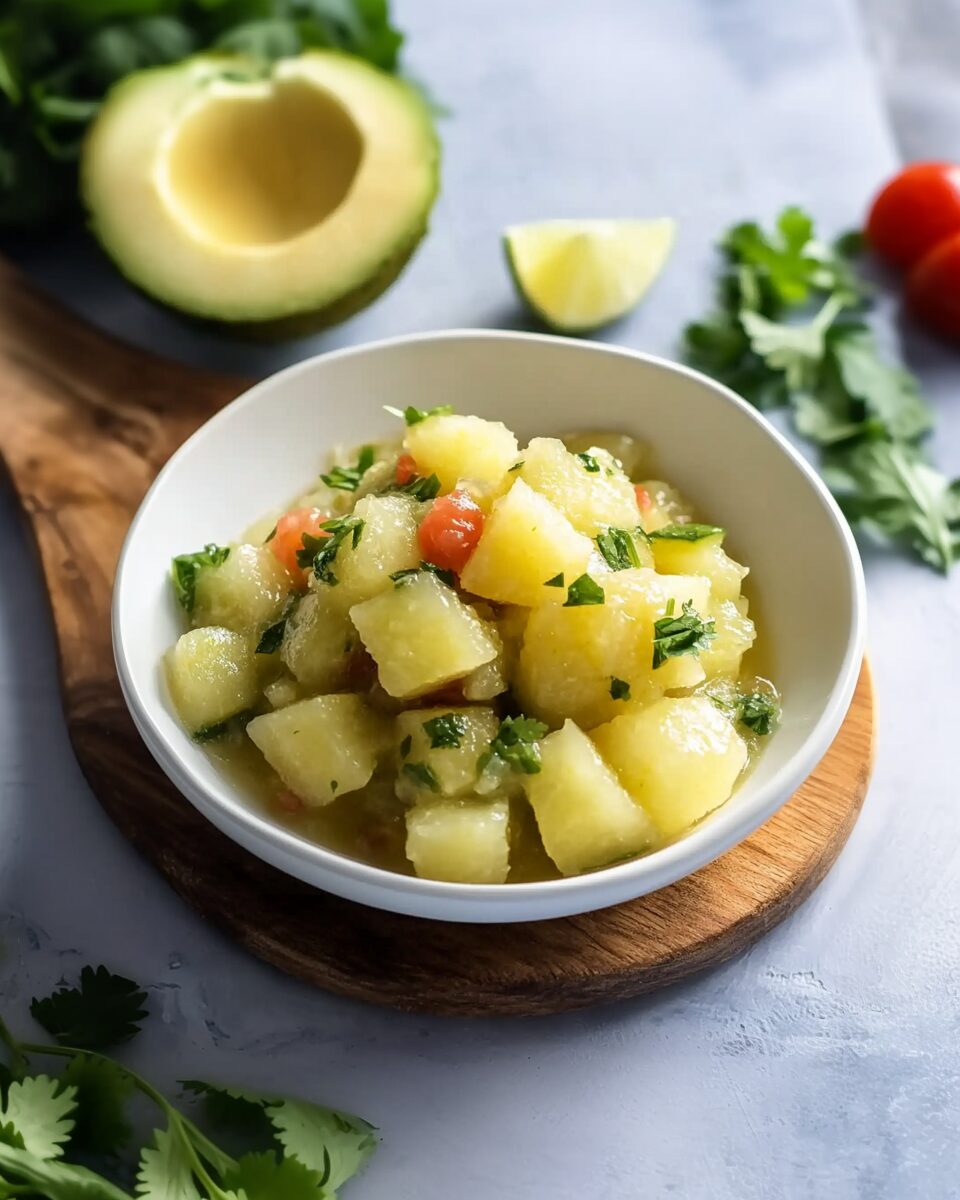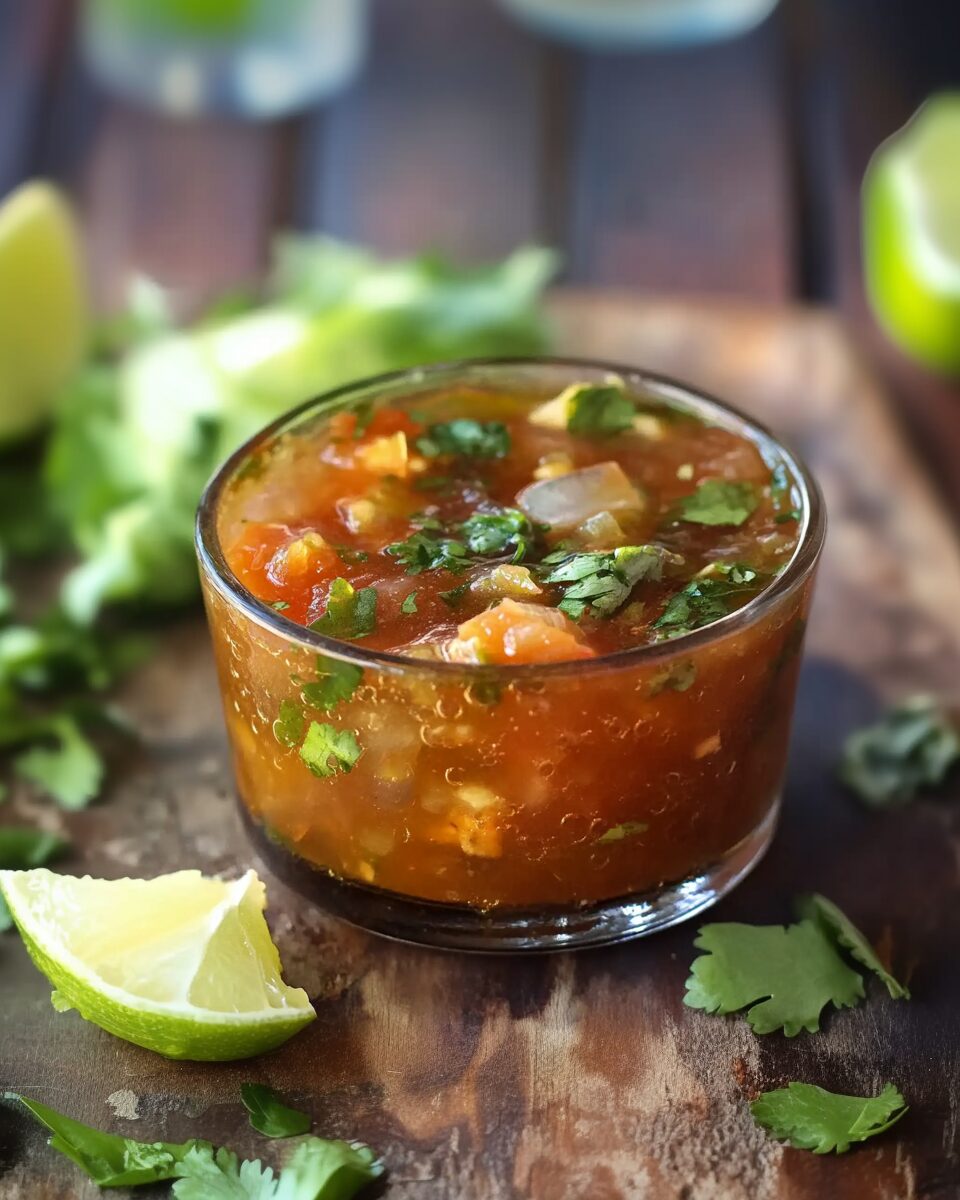Salsa de Piña, or Pineapple Salsa, is a vibrant and refreshing condiment that brings a tropical twist to traditional Mexican flavors. Combining the sweetness of pineapple with the heat of jalapeño and the freshness of cilantro, this salsa is both versatile and easy to prepare. Whether served with tortilla chips, atop grilled meats, or as a zesty topping for tacos, Salsa de Piña adds a burst of flavor to any dish.
Full Recipe:
Ingredients
- 1 can diced pineapple, drained
- ½ jalapeño, finely diced (optional)
- ¼ red onion, finely diced
- ½ bunch of cilantro, chopped
- 1 large tomato, diced
- Salt to taste
Directions
- In a mixing bowl, combine the diced pineapple, jalapeño, red onion, cilantro, and tomato.
- Stir the ingredients together until well mixed.
- Season with salt to taste.
- Let the salsa sit for a few minutes to allow the flavors to meld.
- Serve immediately or refrigerate until ready to use.
Nutritional Facts
Per serving (approximately 1 cup):
- Calories: 9 kcal
- Carbohydrates: 2 g
- Protein: 1 g
- Fat: 1 g
- Saturated Fat: 1 g
- Sodium: 2 mg
- Potassium: 83 mg
- Fiber: 1 g
- Sugar: 1 g
- Vitamin A: 290 IU
- Vitamin C: 6.8 mg
- Calcium: 3 mg
- Iron: 0.1 mg
The History and Origins of Salsa de Piña
Salsa de Piña is a modern take on the traditional salsas found in Mexican cuisine. Mexican salsas are an essential part of the culinary culture, known for their versatility and the ability to complement a wide variety of dishes. While tomato-based salsas and those made with chiles have long been the staples of Mexican cuisine, the introduction of fruit-based salsas, like Salsa de Piña, has added a unique twist to the traditional flavor profiles.
Pineapple itself has been a staple in Latin American cooking for centuries, with the fruit originating from South America and being spread throughout the region by the indigenous peoples and later by European colonists. Over time, pineapple has found its way into both sweet and savory dishes, adding a refreshing and slightly tangy contrast to rich or spicy flavors. Salsa de Piña is part of this evolving trend of integrating fruit into savory recipes, offering a refreshing alternative to more traditional, fiery salsas.
Though Salsa de Piña is popular across Mexico, it is most commonly associated with coastal regions where pineapple and other tropical fruits are grown. The sweet-tasting fruit pairs well with the heat of chilies and the freshness of herbs like cilantro, which are staples of Mexican cuisine. This fusion of flavors reflects the diverse agricultural products of Mexico and showcases the region’s innovative approach to food.
Key Ingredients in Salsa de Piña
The core ingredients of Salsa de Piña include pineapple, jalapeños, cilantro, red onion, and tomato. Together, these components create a well-balanced salsa that complements a variety of dishes, from tacos to grilled meats. While the ingredients themselves may seem simple, their combined flavors make Salsa de Piña a standout condiment.
Pineapple, the star of the salsa, provides a natural sweetness and acidity that enhances the flavor of any dish. The sweetness of the fruit contrasts perfectly with the heat from jalapeños, making each bite an exciting combination of sweet and spicy. Jalapeños, a quintessential ingredient in Mexican cuisine, bring the right amount of heat without overpowering the other ingredients. The diced red onion adds crunch and mild sharpness, providing texture and flavor, while cilantro brings freshness and depth to the salsa. Finally, the tomato adds juiciness and balance, helping to round out the salsa and contribute to its vibrant color.
How to Serve Salsa de Piña
Salsa de Piña is incredibly versatile and can be used in a variety of ways. Traditionally, it is served as a topping for tacos, particularly fish or pork tacos, where the sweetness of the pineapple complements the richness of the meat. The salsa can also be served alongside grilled meats, such as chicken, steak, or pork, providing a fresh contrast to the smoky flavors from the grill. It also pairs wonderfully with seafood, such as shrimp or grilled fish, where the acidity of the pineapple enhances the flavors of the fish.
In addition to its use as a topping, Salsa de Piña can be served as a dip for tortilla chips, crackers, or fresh vegetables. It makes an excellent accompaniment for any type of Mexican fiesta, adding a burst of flavor to party platters and snack tables. For a creative twist, Salsa de Piña can be drizzled over salads or used as a topping for rice bowls or burrito bowls, where its sweetness and tanginess will balance out the other ingredients.
Health Benefits of Salsa de Piña
Salsa de Piña is not only delicious but also offers a number of health benefits, thanks to its nutritious ingredients. The main ingredient, pineapple, is packed with vitamin C, an essential nutrient that supports immune function and helps fight off infections. Pineapple also contains bromelain, an enzyme that aids digestion and reduces inflammation in the body. The presence of cilantro and jalapeños adds additional antioxidants and anti-inflammatory compounds, further enhancing the health benefits of the salsa.
In addition to being rich in vitamins and minerals, Salsa de Piña is also low in calories, making it a healthy option for those looking to add flavor to their meals without overindulging. The use of fresh ingredients means that the salsa is free from preservatives and artificial additives, ensuring that you are consuming a wholesome and nutrient-dense condiment.
Salsa de Piña Variations
Although the traditional recipe for Salsa de Piña is simple and delicious, it offers plenty of room for customization based on your personal preferences. For instance, if you prefer a spicier salsa, you can increase the amount of jalapeño or add other types of chili peppers, such as serrano or habanero, for a more intense heat. If you like your salsa with more acidity, a squeeze of fresh lime juice can add a tangy kick that will brighten up the flavors even more.
For those who enjoy smokier flavors, try roasting the pineapple and tomatoes before adding them to the salsa. This technique caramelizes the natural sugars in the fruit and vegetables, creating a richer, deeper flavor. You can also experiment with adding other fruits to the salsa, such as mango, papaya, or even kiwi, to create a unique variation that reflects your taste preferences.
Conclusion
Salsa de Piña is a delightful, tropical salsa that can add excitement and fresh flavors to a variety of dishes. Whether you’re serving it as a dip, topping for tacos, or accompaniment to grilled meats, this sweet and spicy salsa is sure to impress. Its combination of fresh pineapple, spicy jalapeños, crunchy onions, and fragrant cilantro creates a balance of flavors that can elevate any meal.








